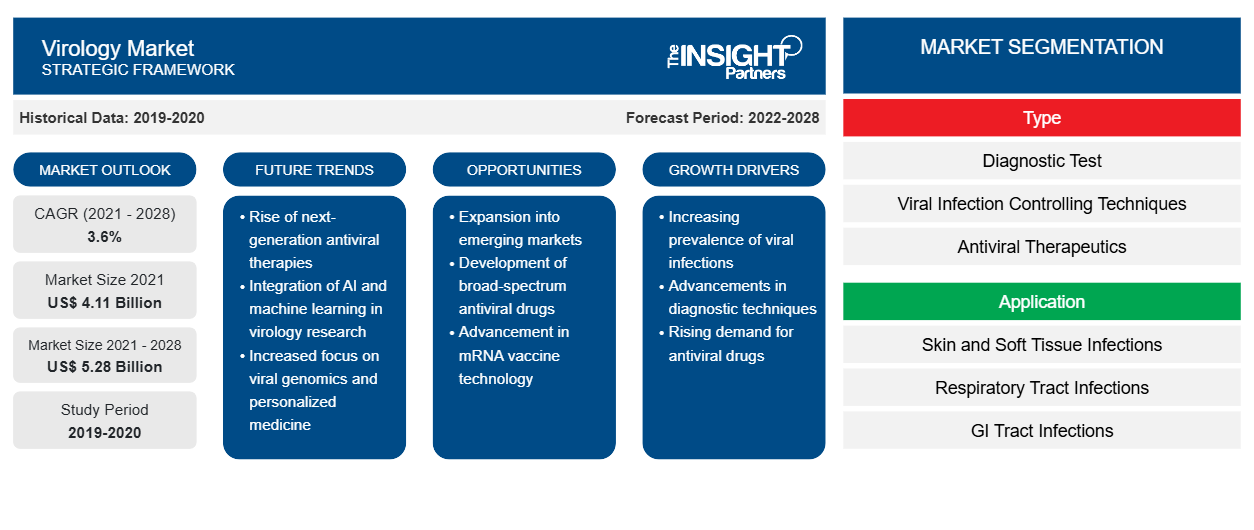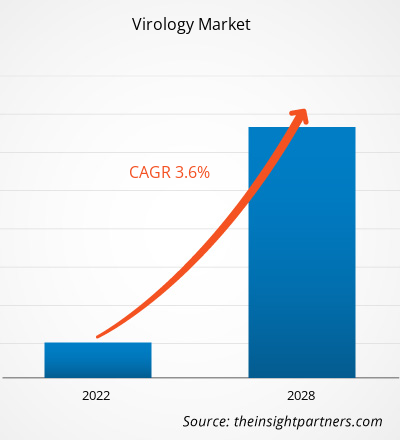من المتوقع أن يصل سوق علم الفيروسات إلى 5،276.48 مليون دولار أمريكي بحلول عام 2028 من 4،108.27 مليون دولار أمريكي في عام 2021؛ ومن المتوقع أن يسجل معدل نمو سنوي مركب بنسبة 3.6٪ من عام 2021 إلى عام 2028.
يُعدّ علم الفيروسات من أهمّ القطاعات في نظام الرعاية الصحية، وله تطبيقات واسعة في تطوير اللقاحات، والتشخيص، والعلاجات، وغيرها. ويشارك المتخصصون في سوق علم الفيروسات باستمرار في ابتكار وتطوير المنتجات للحفاظ على المنافسة في السوق، ويستكشفون مجالاتٍ مختلفةً لابتكار المنتجات. على سبيل المثال، بالنسبة لكوفيد-19، يستثمر المتخصصون في السوق بشكل كبير في تطوير اللقاحات، وأدوات الاختبار، وغيرها من المنتجات والخدمات ذات الصلة. فيما يلي بعض التطورات السوقية المتعلقة بسوق علم الفيروسات.
- في أغسطس 2021، وافقت إدارة الغذاء والدواء الأمريكية (FDA) على أول لقاح لكوفيد-19، المعروف باسم لقاح فايزر-بيونتيك لكوفيد-19. سيتم تسويقه باسم كوميرناتي (Koe-mir'-na-tee). يهدف اللقاح إلى الوقاية من مرض كوفيد-19 لدى الأفراد الذين تبلغ أعمارهم 16 عامًا فأكثر. وهو متاح أيضًا بموجب ترخيص الاستخدام الطارئ (EUA).
- في أبريل 2021، أطلقت شركة CerTest Biotec اختبار التشخيص COVID-19 الحاصل على علامة CE لنظام BD MAX.
- في مايو 2020، حصلت شركة Bio-Rad على موافقة إدارة الغذاء والدواء الأمريكية على ترخيص الاستخدام الطارئ لاختبار الأجسام المضادة الكلية لـ COVID-19.
- في مايو 2020، أطلقت شركة Aalto Bio Reagents بروتينات سبايك S1-S2 حقيقية النواة المعاد تركيبها لفيروس SARS-CoV-2.
ومن ثم، فإن هذه المشاركة الفعالة من جانب اللاعبين في السوق من خلال ابتكارات المنتجات والدعم الحكومي في مختلف البلدان تعزز نمو سوق علم الفيروسات.
ستحصل على تخصيص لأي تقرير - مجانًا - بما في ذلك أجزاء من هذا التقرير، أو تحليل على مستوى الدولة، وحزمة بيانات Excel، بالإضافة إلى الاستفادة من العروض والخصومات الرائعة للشركات الناشئة والجامعات
سوق علم الفيروسات: رؤى استراتيجية

- احصل على أهم اتجاهات السوق الرئيسية من هذا التقرير.ستتضمن هذه العينة المجانية تحليل البيانات، بدءًا من اتجاهات السوق وحتى التقديرات والتوقعات.
رؤى السوق: تزايد اعتماد الإجراءات التجميلية قليلة التدخل وغير الجراحية يدفع نمو سوق علم الفيروسات
تصيب فيروسات مثل فيروس نقص المناعة البشرية (HIV)، وفيروس الإنفلونزا، وفيروس زيكا، وفيروس إيبولا، وفيروس سارس-كوف-2، وفيروس شلل الأطفال أعدادًا كبيرة من السكان حول العالم. ومع تحور الفيروس وتطوره المستمر، تُصبح مقاومة الأدوية تحديًا كبيرًا في إدارة العدوى الفيروسية بين البشر والحيوانات. ينتقل الفيروس عبر وسائل نقل مختلفة حسب نوعه. على سبيل المثال، تُسبب بعض الفيروسات أمراضًا فيروسية تنفسية، مثل الإنفلونزا، ونزلات البرد، والعدوى بالفيروس المخلوي التنفسي، وتنتقل عبر الرذاذ الناتج عن السعال أو العطس، بينما تنتقل بعض الأمراض الفيروسية المعوية عن طريق التلامس المباشر مع براز المصابين أو عن طريق الطعام أو الماء الملوث. وفقًا لإحصاءات برنامج الأمم المتحدة المشترك المعني بفيروس نقص المناعة البشرية والإيدز العالمية، أصيب أكثر من 37.7 مليون شخص في جميع أنحاء العالم بفيروس نقص المناعة البشرية في عام 2020. أعلنت اللجنة الدولية لتصنيف الفيروسات (ICTV) أن فيروس كورونا الجديد الذي تسبب في مرض كوفيد-19 هو فيروس كورونا 2 المسبب لمتلازمة الجهاز التنفسي الحادة الوخيمة (SARS-CoV-2) في فبراير 2020. وقد خضع الفيروس لطفرة مرتين منذ تفشيه، مما زاد من شدة جائحة كوفيد-19. على سبيل المثال، وفقًا لبيانات متتبع كوفيد-19 الصادرة عن مراكز السيطرة على الأمراض والوقاية منها (CDC)، اعتبارًا من أغسطس 2021، يبلغ معدل الحالات لمدة سبعة أيام لكل 100000 شخص 299.4، وتم الإبلاغ عن أكثر من 164952 حالة جديدة في الولايات المتحدة . علاوة على ذلك، ووفقًا للمركز الأوروبي للوقاية من الأمراض ومكافحتها، بلغ إجمالي عدد حالات كوفيد-19 في المنطقة الاقتصادية الأوروبية (EEA) حتى أغسطس 2021 حوالي 36,307,572 مريضًا. وبالتالي، يُسهم هذا الانتشار المتزايد للعدوى الفيروسية في نمو سوق علم الفيروسات.
رؤى إقليمية حول سوق علم الفيروسات
قام محللو شركة "ذا إنسايت بارتنرز" بشرح شامل للاتجاهات والعوامل الإقليمية المؤثرة في سوق علم الفيروسات خلال فترة التوقعات. ويناقش هذا القسم أيضًا قطاعات سوق علم الفيروسات ونطاقه الجغرافي في أمريكا الشمالية، وأوروبا، وآسيا والمحيط الهادئ، والشرق الأوسط وأفريقيا، وأمريكا الجنوبية والوسطى.
نطاق تقرير سوق علم الفيروسات
| سمة التقرير | تفاصيل |
|---|---|
| حجم السوق في عام 2021 | 4.11 مليار دولار أمريكي |
| حجم السوق بحلول عام 2028 | 5.28 مليار دولار أمريكي |
| معدل النمو السنوي المركب العالمي (2021 - 2028) | 3.6% |
| البيانات التاريخية | 2019-2020 |
| فترة التنبؤ | 2022-2028 |
| القطاعات المغطاة | حسب النوع
|
| المناطق والبلدان المغطاة | أمريكا الشمالية
|
| قادة السوق وملفات تعريف الشركات الرئيسية |
|
كثافة اللاعبين في سوق علم الفيروسات: فهم تأثيرها على ديناميكيات الأعمال
يشهد سوق علم الفيروسات نموًا سريعًا، مدفوعًا بتزايد طلب المستخدمين النهائيين نتيجةً لعوامل مثل تطور تفضيلات المستهلكين، والتقدم التكنولوجي، وزيادة الوعي بفوائد المنتج. ومع تزايد الطلب، تعمل الشركات على توسيع عروضها، والابتكار لتلبية احتياجات المستهلكين، والاستفادة من الاتجاهات الناشئة، مما يعزز نمو السوق.

- احصل على نظرة عامة على أهم اللاعبين الرئيسيين في سوق علم الفيروسات
رؤى قائمة على النوع
بناءً على النوع، يُقسّم سوق علم الفيروسات إلى اختبارات تشخيصية، وتقنيات مكافحة العدوى الفيروسية، وعلاجات مضادة للفيروسات، وإنترفيرونات. في عام 2021، من المتوقع أن يستحوذ قطاع الاختبارات التشخيصية على الحصة الأكبر من السوق، وأن يُسجل قطاع تقنيات مكافحة العدوى الفيروسية أعلى معدل نمو سنوي مركب خلال الفترة 2021-2028.
رؤى قائمة على التطبيق
بناءً على التطبيق، يُقسّم السوق إلى التهابات الجلد والأنسجة الرخوة، والتهابات الجهاز التنفسي، والتهابات الجهاز الهضمي، والأمراض المنقولة جنسيًا، والتهابات المسالك البولية، وغيرها. في عام 2021، من المتوقع أن يستحوذ قطاع التهابات الجهاز التنفسي على الحصة الأكبر من السوق، ومن المتوقع أن يُسجل أعلى معدل نمو سنوي مركب خلال الفترة 2021-2028.
تُركز الشركات العاملة في سوق علم الفيروسات على تبني استراتيجية ابتكار المنتجات لتلبية متطلبات العملاء المتغيرة حول العالم، مما يُمكّنها أيضًا من الحفاظ على مكانتها في السوق العالمية.
سوق علم الفيروسات - التجزئة
حسب النوع
- اختبار التشخيص
- اختبار فيروس الحمض النووي
- اختبار فيروس الحمض النووي الريبوزي
- آحرون
- تقنيات السيطرة على العدوى الفيروسية
- الوقاية النشطة
- الوقاية السلبية
- العلاجات المضادة للفيروسات
- العوامل القاتلة للفيروسات
- العوامل المضادة للفيروسات
- منظمات المناعة
- الإنترفيرونات
حسب الطلب
- التهابات الجلد والأنسجة الرخوة
- التهابات الجهاز التنفسي
- التهابات الجهاز الهضمي
- الأمراض المنقولة جنسياً
- التهابات المسالك البولية
- آحرون
حسب المستخدم النهائي
- المستشفيات
- مختبرات التشخيص
- شركات الأدوية والتكنولوجيا الحيوية
- المعاهد البحثية والأكاديمية
حسب الجغرافيا
- أمريكا الشمالية
- نحن
- كندا
- المكسيك
- أوروبا
- فرنسا
- ألمانيا
- إيطاليا
- المملكة المتحدة
- إسبانيا
- بقية أوروبا
- آسيا والمحيط الهادئ
- الصين
- الهند
- كوريا الجنوبية
- اليابان
- أستراليا
- بقية منطقة آسيا والمحيط الهادئ
- الشرق الأوسط وأفريقيا
- جنوب أفريقيا
- المملكة العربية السعودية
- الإمارات العربية المتحدة
- بقية الشرق الأوسط وأفريقيا
- أمريكا الجنوبية والوسطى
- البرازيل
- الأرجنتين
- بقية الاحتيال
ملفات تعريف الشركة
- أبوت
- شركة جونسون آند جونسون للخدمات المحدودة
- شركة ف. هوفمان-لا روش المحدودة
- شركة ثيرمو فيشر العلمية
- كياجن
- شركة إيلومينا
- شركة سيمنز ايه جي
- شركة جلاكسو سميث كلاين بي إل سي
- شركة جيلياد للعلوم
- شركة آبفيأسماء حقوق الطبع والنشر الواردة في المواقع الإلكترونية المعنية.
- التحليل التاريخي (سنتان)، سنة الأساس، التوقعات (7 سنوات) مع معدل النمو السنوي المركب
- تحليل PEST و SWOT
- حجم السوق والقيمة / الحجم - عالمي، إقليمي، بلد
- الصناعة والمنافسة
- مجموعة بيانات إكسل
التقارير الحديثة
شهادات العملاء
سبب الشراء
- اتخاذ قرارات مدروسة
- فهم ديناميكيات السوق
- تحليل المنافسة
- رؤى العملاء
- توقعات السوق
- تخفيف المخاطر
- التخطيط الاستراتيجي
- مبررات الاستثمار
- تحديد الأسواق الناشئة
- تحسين استراتيجيات التسويق
- تعزيز الكفاءة التشغيلية
- مواكبة التوجهات التنظيمية




















 احصل على عينة مجانية ل - سوق علم الفيروسات
احصل على عينة مجانية ل - سوق علم الفيروسات